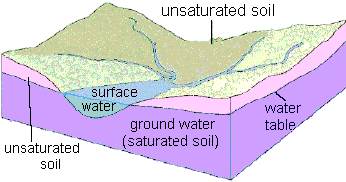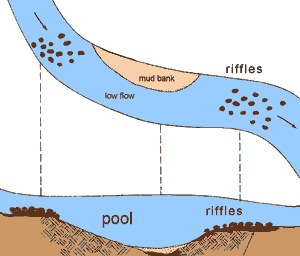 |
| Water movement |
Movement of Water
Surface movement includes rivers, streams, creeks, lakes, ponds, and human-made "flood" control. All surface water is trying to reach sea level due to gravity. As water flows in channels, the streambed and banks of the channel will resist the flow of water. The velocity of the water is dependant on steepness of the slope, type of rock or soil, amount of vegetation, shape of stream bed, and obstructions. Surface water provides the liquid where most evaporation takes place.
 |
| Water movement |
Groundwater refers to water that has penetrated the soil or bedrock and moves through rocks that have a high pore space. The water comes from infiltration of surface waters including lakes, rivers, recharge ponds, and even waste-water treatment systems. Groundwater is also affected by the force of gravity. However, because of some of the properties of water, it can pool in higher area and actually defy gravity in some cases. The water stable is the upper level of the saturated zone of groundwater.
Rivers, streams and creeks are a surface water system with a network of channels that collect and move runoff. Runoff is excess water that is not adsorbed by the surrounding area. Runoff can be created by rainfall, melting snow, or groundwater discharge. The shape of the river system will depend on the topography, the type of rock or soil it is traveling through, and the style of its biological diversity. For instance, pine trees require a lot of water to grow. Runoff in a pine tree forest would be less than if the area was populated by oak trees. Oak trees require less water than pine, so more water would be available as runoff.
Rivers and streams change depending on the amount of water that flows throughout the year. This relies on a continuous source of water is from the surface or subsurface. A perennial flow is a channel that has water all year round. An example would be the great rivers of the world including the Ganges River (India), Amazon River (South America), or the Nile River (Africa). An intermittent stream would be a flow that is more than 50% during the year. An ephemeral flow generally refers to a stream or creek that only has water part of the year. This is usually in areas, like deserts, that are dry most of the year, but do have maybe 2 months of rain.
Surface flows will wiggle and wind through the surface landforms. There are many flow types depending on the velocity of the river. If the velocity is high, it tends to cut into bedrock in a "straight" line. Velocities will be high if there is sufficient relief. When the velocity is low, the stream will tend to meander if the rock type and topography permit it.
 |
| Stream diagram |
Water velocity helps to create three basic types of channel patterns, including braided, meandering, and straight. There are many patterns that grade into each other. Rivers in a straight pattern do not stay ruler straight for long! The physical properties of water and the area the river is eroding tend to have the deepest part of the river (called the thalweg) alternating from side to side on the channel. Erosion of the land starts a physical separation of the pieces. Larger pieces don
’t move very far and drop out of the system. However, finer grained sediment settles out in quieter area. So water will be attacking one side of the river and the other side will be depositing sediment. Over the years this will create meandering.In many areas where you find braided channels, surface water is just "dumped" into a lower topographic area. The sediment load is large and the river gets confused and breaks up into smaller channels with a branching, but braided look.
The flow will also dictate how the sediment is deposited, which in turn contributes to the type of habitat available to different types of organisms. Three types of bedforms provide excellent "living" space, including mud, riffles, and pools. The accumulation of fine-grained sediments (mud) in quiet rivers can influence growth for small invertebrates and fish eggs. The mud represents a "cushion", and if disturbed because of increased movement of water, can cause damage to the organisms that live there.
Riffles are relatively shallow portions of a river with a change in elevation where water cascades over cobbles or boulders along its path. The fast-moving water allows gas in the atmosphere to mix with the water, therefore increasing the dissolved oxygen that enters the water system. Behind the rocks are areas that debris can build up and act as a habitat for fly larvae and other small invertebrates.
Pools of water are areas that are deeper. When water reaches a pool the velocity of the water slows down, making it an excellent resting place for fish.
 |
| Various types of rock sorting that can trap water. |
Ground water as it moves through soil and rock is actually being naturally filtered. Some substances like sand can help filter pollutants and particles easily. Clays in soil and rock also act as a way to "capture" and exchange some elements and compounds when they are dissolved in water. This helps to eliminate other pollutants that filtration cannot handle.
Water is stored in aquifers, which have similar characteristics of reservoir rocks that store soil and gas. Well-sorted sediments with high porosity (A) and highly fractured (C) rocks are excellent candidates for aquifers. If poorly sorted rocks are partially cemented (B), they are not good reservoir rocks. The fluid must have room to move around. An aquifer is not an underground river, it just retains the water until it is pumped out through a well or naturally emerges as a spring.